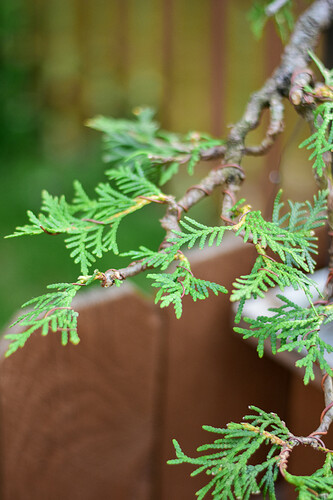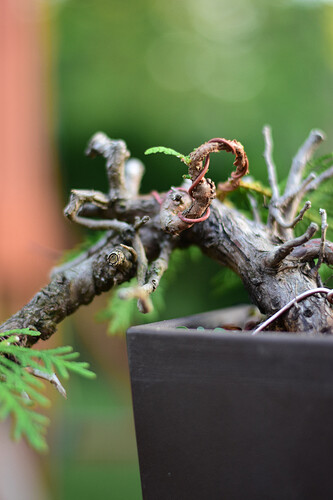I’ve wanted to get better about documenting my trees…so here we go!
This is a Thuja that I collected on the bank of a river that my grandparents used to have a cottage on. I collected it in late September about 6 years ago - I was a few years in to my practice but was still green enough that I wouldn’t have called it a “practice”.
What drew me to this tree, and really any tree along that river was the fact that they were either tall, regal trees (along the straight stretches) or tortured, stunted trees at every turn (every year, large ice flows take out docks, trees, rocks or anything in their path. It’s a constantly evolving riverbank. This particular tree lay nearly flat when I collected it - with long, thin, branches. It did not appear to be a tree that tipped over, but a tree that never had a chance to grow upwards and likely saw vertical growth decimated every winter.
Thuja as of 6/02/20
Being a collecting novice, I dug the tree on a cold morning, wrapped it in burlap and happily brought the tree back home with me. I put it in a raised cinderblock bed filled with garden soil - rootball still wrapped in burlap. That winter we saw extreme cold, dry winds, ice storms, etc. The following spring my wife and I moved in to what would now be our current house and I was forced to pull the tree from the bed in mid March. The ground was still frozen but it was either take it our leave it. Instead of try to put it back in the ground at our new home, I put it in this generic cascade you see today.
Over the course of the next 5 years, I attempted to learn how to handle the fronds. As luck would have it our house has a large Thuja hedgerow in the backyard that has allowed me to test all kinds of pinching and pruning methods. This proved helpful but I never really felt like I knew what I was doing. Constantly coming back each fall thinking about what I wish I had done and never really feeling like I was capturing the airy, natural feeling of the species I grew to love while canoeing down the river.
What I realize now are two things: 1. I should have subscribed to Mirai a long time ago and 2. I should have never listened to the internet about what this tree should be.
Thuja as thinned and tweaked 6/18/20
Yesterday I came back to this Thuja as I do every year about this time, but with a new outlook and a clearer intention - correct the flaws I have now created with misguided pruning and pinching methods and get back to seeing the elegance and openness I love about the species.
The first thing I tackled was the branching.
As you can see in the original photo, the tree became quite dense, but if left uncorrected, it would have simply started to look like a bush and no branch structure would have formed. I wanted to focus on cutting back to vigorous, horizontal growth which in a lot of cases meant I was eliminating old shoots that were original to when I collected it but also the profusion of growth (headed in every direction) that the tree responds with when pinched. I expect to need to replace branches every few years to maintain the scale of the tree.
As many of you will find by doing a generic search of other forums or Google, there’s a lot to do about creating “density” with Thuja. My learned knowledge of following some of that advice is: do not follow it if you have a smaller tree or don’t fully understand the growth habits and response of the species. Pinching, as is often suggested, is something that I did not understand and you can see the results. The reason many of the old branches needed to be eliminated was due to the fact that this tree wants to survive. It wants to push push push and will sacrifice any branch to find the path of least resistance.
One thing I love about this tree in particular is the branches that naturally wrap around and under themselves/other branches. Presumably to push past other trees/grasses/etc that would have kept the branches from elongating normally. You can see one of them in the above photo, upper right. In having spent the last 5 years building the vigor of this tree, it has produced many new shoots on old wood, this one below actually having sprouted where a small old jin existed. It’s counter intuitive to the cascade design to let it grow but for the past 2 seasons I’ve let it elongate in order to this year wire and wrap it up and around to the backside of the tree where it will continue to grow. I plan to build another set of pads on the back of the tree for depth. Is the loop unnatural? It sure looks like it, but I like a bit of unnatural and the fact that I can find other, natural, occurrences of it on the tree has had me questioning how right we are about those kinds of questions.
If you’ve made it this far: I appreciate your time.
Hopefully I’ve done a good job in helping you see what I see in this tree. I’d love to hear any opinions about where it could head in the future (could I lose those two lowest branches?) For 2021 it will be put in it’s first proper pot. No idea what that looks like yet but would love to hear opinions on that as well.
Last thing, and at the risk of sounding like a fanboy - thanks to Mirai for the platform to learn about species like these that are rife with misguided internet advice.
Thanks!




